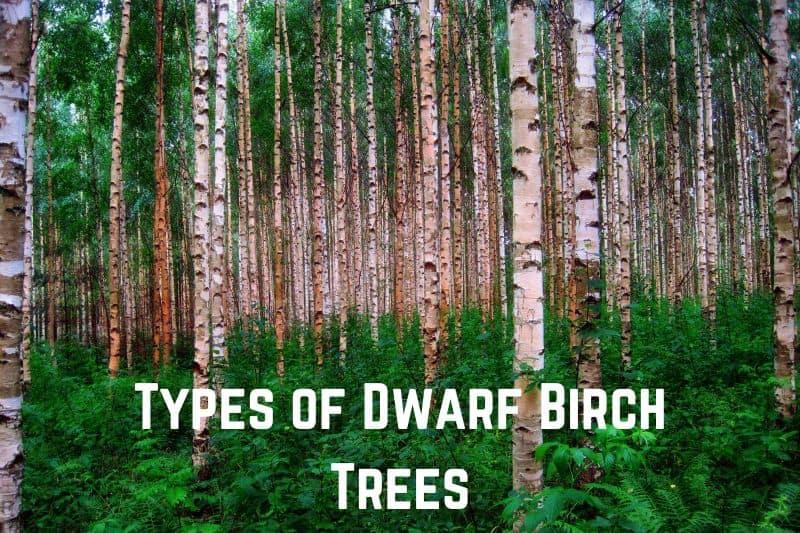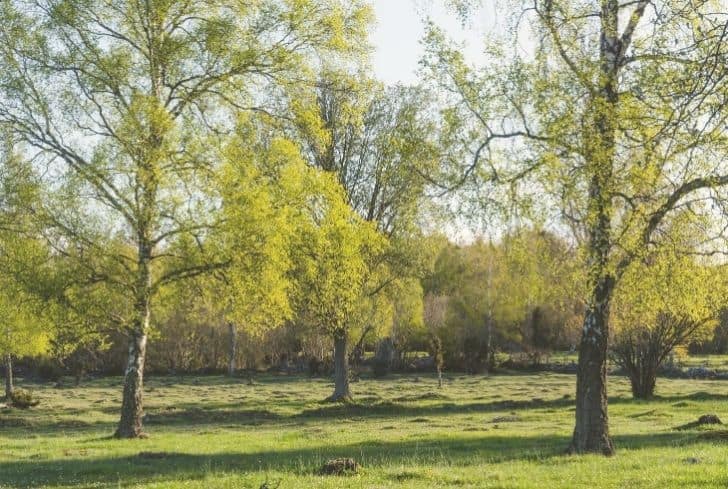Who doesn’t love the look of the color-changing birch leaves and the tree’s exquisite silvery bark?
I guess we all do!
Whether it’s the full elegance in winter or the vibrant green during fall, the sight is truly remarkable.
In fact, it’s no wonder these trees are becoming homeowners’ favorite choice for their landscaping needs.
But did you know that there are over 60 birch species?
That’s right!
And surprisingly, these trees all have different growth rates and nutrient requirements. This article digs into some common species, clearly unearthing essential details for each.
Let’s dive right in!
What Is Landscaping?
Just before we get to the birch trees, you might wonder what landscaping is all about. And why birch trees are a relevant option.
Well, we’re about to tell you!
Landscaping is the summation of everything you do to maintain a garden in your home. It entails a variety of tasks, from weed trimming to planting trees and land mowing.
Now, when it comes to dwarf birch trees, they are, just like the name suggests, short. They are usually grown to fit into a small space.
However, despite the shortness, these trees can make a bold statement in your garden.
In other words, birch trees will easily fit into the needs of a small garden while still providing the beauty and glamour of the renowned birch tree. Great right?
9 Types of Dwarf Birch Trees that You Can Use for Landscaping
Now, let’s get to the 9 top dwarf birch trees that are an excellent choice for your landscaping needs.
1. Snow Queen Birch Tree
The snow queen, also known as ‘Betula utilis’, is a favorite for many. Perhaps that’s because of its slender, medium-sized feature and snowy-white appearance.
The tree is an all-round garden asset as its beauty radiates through its foliage. And with it, you get various colors at different seasons.
In the spring, its foliage brings out vibrant yellow catkins amidst its mid-green color. In autumn, it turns golden-yellow. Then, just before fall, a shade of bronze comes on the leaves, with winter making the snow queen’s bark more profound and deeply admirable.
You might find it intriguing that the beauty of the snow queen tree becomes even more striking when planted in groups of three. This arrangement makes the different colors stand out and adds extra brightness to your garden.
The beautiful tree eventually grows upright and takes the shape of a pyramid. And with all the beauty it radiates all year round, it’s a strong candidate for anyone looking for a tree for all seasons.
2. Trinity College Birch Tree
Like the snow queen, the Trinity College birch or ‘Betula Jacquemontii’ is white-barked and slender in form. The name stems from its origin as it comes from a tree in Trinity College, Dublin.
The Trinity College takes about ten years to grow substantially above 15 feet. It is an excellent choice for small gardens due to its modest structure.
It develops its bark at a very tender age. As such, you can expect the tree to create an enchanting appeal that adds value to your backyard right from a young age.
you’re good to go should you decide to plant the Trinity College birch. You don’t have to wait forever to derive satisfaction from its beauty.
Consider it if your garden could use a bit of color or more brightness. It also does well in full sun, where the reflection brings further glee to its beauty.
3. Fastigiata Birch Tree
This tree is peculiar to other birch trees, as it has a silvery bark. It also has an aura of elegance that accompanies it. The tree can grow too big for small gardens, however, but that doesn’t stop it from being a great choice.
Typically, the Fastigiata birch tree has green foliage. However, in autumn, it turns yellow.
In winter, the leaves of the Trinity College birch may drop, but this transition only enhances its beauty. As the leaves fall, the bark becomes more prominent, adding a splash of color to your garden.
In addition, you should know that the Fastigiata birch tree has an upright appearance. And this is a result of the intertwined and inward growth of the branches.
So, if your garden could use a vertical accent, you’ve got yourself a pick. The Fastigiata birch will fit in perfectly.
4. Cesky Gold Dwarf Birch Tree
As an addition, the Cesky gold birch tree can be a great option. It typically takes the form of a shrub rather than a tree. As such, it fits perfectly into a garden scenery.
Its leaves are usually red, yellow, and red in the spring. By summer, the leaves take the color green.
Also, because it is pollution-tolerant, it is suitable for urban and rural areas. One thing you’ll be sure to get with this choice is beauty. And one combined with a scenic view at that.
5. Little King Birch Tree
This is a petite-friendly birch tree that you can use for landscaping. It grows fast and has multiple stems, forming well into a tent.
This tree is a great choice if you have a garden near a pond or stream, and that’s simply because it thrives well in wet soil.
Also, this species comes in handy for gardeners with limited time to tend to the plants. It requires very little pruning and no fertilizer application, so it’s a low-maintenance option generally.
As always, it brings elegance and beauty to your garden. So, if you want to achieve this in your garden, go with it.
6. Magical Globe Birch Tree
The Magical Globe birch is a dwarf-like tree with immensely attractive and distinct features. You’ll need to see its silver-like trunk and round-shaped top to understand this beauty fully.
Looking like a lollipop, this tree grows very slowly with tight branches.
The tree typically possesses mid-green foliage, a color that stays throughout all seasons. But there’s an exception — in autumn, the tree turns yellow.
The Magical Globe Birch is a perfect option for small gardens and is suited for all soil types. You can also grow it in a large pot.
They are mostly planted in large quantities and used as border pathways. So, you might want to use them this way.
7. Grayswood Ghost Birch Tree
This is also one tree that can be highly serviceable in landscaping.
With this option, you get a snow-white bark and dark green leaves that occasionally transform into a golden cream color.
The tree is truly a sight to behold, and its Award of Garden Merit of the Royal Horticultural Society is there to prove it.
Like the little king birch tree, the Grayswood Ghost also requires little or no maintenance. It is the perfect plant to use as a specimen or a borderline.
This birch species thrives well in wet soil. So, this would be the right choice if you have a garden close to a stream or pond.
8. Erman’s Birch Tree
It also can be called the Betula ermanii. This particular birch tree exudes grace and beauty. If you want to give your garden some life, it’s one of the greatest choices.
Also, thanks to its growth rate, this tree is a perfect fit for landscaping. It is always attractive and elegant in respective of the season. Concurrently, it also requires little or no maintenance. You can also use it in a wide range of soils.
9. River Birch Tree
It is also known as the Betula Nigra. They have ornamental trunks coupled with scaly bark. So, if you hope to have plants that can make a statement, the river birch is your best bet.
The River birch also has varieties with less dramatic barks that would complement the colors of several other foliage. An example is Heritage’ which has a lighter gray bark.
They grow relatively fast and rise as tall as 40 feet in 20 years. However, their life span can be relatively short.
Another great thing is that it helps in providing shade to other plants. This is because its leaves spread out to form a tent. So, it’s best to plant it in the middle of the garden. This way, it would stand out among the shrubs and be the center of attraction.
Conclusion
Choosing landscaping as an activity to engage in seems like an arduous task. It gets even trickier deciding the type of plants in your garden.
Well, Dwarf Birch Trees are a great choice. But then, thanks to the plethora of species available, choosing the ideal one for your needs might be a perplexing affair.
But not any longer. With the 9 reviewed options, you should now be in a position to know what works best for your garden and what doesn’t!







